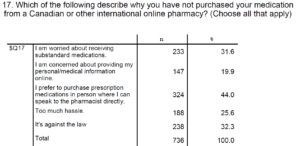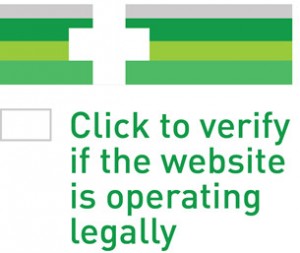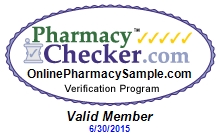by Gabriel Levitt, President, PharmacyChecker.com and Prescription Justice | May 19, 2017 | Advocacy, Policy, Public Health, Skipping medications
 According to a Zogby Poll (see graphic) conducted in February of this year, 31.6% of Americans who said they have never ordered a medication online from another country cited fear of substandard drugs. Another 32.3% cited the law restricting the practice. Most often (44%) people said they preferred to get medication from local pharmacists, which I liked – but I’m aware that for that group affordability was less of an issue.
According to a Zogby Poll (see graphic) conducted in February of this year, 31.6% of Americans who said they have never ordered a medication online from another country cited fear of substandard drugs. Another 32.3% cited the law restricting the practice. Most often (44%) people said they preferred to get medication from local pharmacists, which I liked – but I’m aware that for that group affordability was less of an issue.
What bothers me is that out of the 45 million Americans who did not fill a prescription in 2016 due to cost, how many would have been able to if educated properly about safe international online pharmacies or if the law was more permissive? (more…)
Tagged with: scare tactics, zogby
by Gabriel Levitt, President, PharmacyChecker.com and Prescription Justice | Mar 2, 2016 | Drug Prices, Generic drugs, Skipping medications, Specialty Drugs
According to a new AARP drug price report, in 2006 the average cost of prescription medication increased by 3.6%, just a little higher than the rate of inflation in the U.S. which was 3.2% that year. In 2013, in stark contrast, drug costs were up 9.4% above 2012 with a corresponding rate of inflation of 1.5%. In fact, the average annual cost of popular medications for chronic conditions used by seniors went from $4,140 in 2005 to $11,341 in 2013.
Many of these brand drugs are covered by private and public pharmacy benefit plans, including Part D – but too often they are not, which leaves Americans having to foot the bill out of pocket. Even covered brand name drugs often mean very high co-payments or co-insurance. If you’re paying out of pocket and can’t afford your brand name drug, international online pharmacies have much lower prices – an average of 84% less on a basket of popular medications.
In the past, AARP has been criticized, not surprisingly by the pharmaceutical industry, for just looking at brand name drug prices in its drug price reports and not generics, which help moderate increases. But this latest report measured 622 drugs, a large basket that included brand, specialty and generic drugs. Brand and specialty drug prices were up an average of 12.9% and 10.6%, respectively, compared to a decrease in average generic drug prices of 4%.
AARP’s report concludes that it’s possible, “we can no longer rely on lower priced generics to counterbalance the price trends seen in the brand name and specialty prescription drug markets.” And things appear to be getting worse.
After reading the report, which looked at prices up to 2013, I was curious to find out how much brand name prices increased last year. In 2015, brand name drugs still under patent were up almost 15%, and generics, which tend to get cheaper, had even increased by almost 3% on average [Source]. These drug price increases corresponded with an inflation rate increase of .1%!
With about 30 million Americans still uninsured, many more millions of underinsured with inadequate pharmacy benefits, and drug prices continuing their ascent, tens of millions of Americans will continue to forgo prescribed medication entirely. Fewer will have to make this choice by comparing drug prices among safe international online pharmacies and local pharmacies using prescription discount cards at www.pharmacychecker.com.
Tagged with: AARP Drug Price Report
by Gabriel Levitt, President, PharmacyChecker.com and Prescription Justice | Dec 31, 2015 | Drug Importation, Drug Prices, Online Pharmacies, Skipping medications

As we move out of 2015 and into 2016 with a strong wave of hostility rising throughout the country about high drug prices, what I’m about to report may seem incongruous. Fewer Americans seem to be buying lower cost medications from other countries. For the past few years, largely based on data from the CDC in 2013, I’ve published the number five million as the approximate number of Americans who, due to high drug prices, import medication annually for personal use. But a newer CDC report published in 2015 (that I recently came across) puts that number closer to four million, a 20% decrease.
If drug prices are going up, and Americans are fed up with prescription costs, wouldn’t you expect more people to be buying lower cost medications from outside the country? With fewer Americans buying medication internationally, potentially one million, how many of them are simply not taking prescribed medication? Are our most trusted authorities scaring Americans away from obtaining lower cost medications from other countries, or has affordable access improved over the past few years?
(more…)
Tagged with: Alliance for Safe Online Pharmacies, CDC, Center for Safe Internet Pharmacies, Drug Importation, Drug Prices, FDA, National Association of Boards of Pharmacy, Online Pharmacies, Partnership for Safe Medicines, Patent Cliff, Seroquel, United States
by Gabriel Levitt, President, PharmacyChecker.com and Prescription Justice | Jul 1, 2015 | Advocacy, Online Pharmacies, Online Pharmacy Verification Services, Skipping medications
 Today, online pharmacies that are based and selling medication internationally within the European Union (EU) are required to publish a new EU online pharmacy logo, as shown in the image to your left. We have updated our Verification Program requirements to reflect the EU’s new rules. The practice of international pharmacy is expressly legal within the EU, unlike between, say, the U.S. and Canada, although some EU member countries place national restrictions limiting the scope of cross-border sales. Only online pharmacies based in the member states of the EU are eligible for the new seal. Each seal will contain a special link that consumers can click to verify the seal’s authenticity.
Today, online pharmacies that are based and selling medication internationally within the European Union (EU) are required to publish a new EU online pharmacy logo, as shown in the image to your left. We have updated our Verification Program requirements to reflect the EU’s new rules. The practice of international pharmacy is expressly legal within the EU, unlike between, say, the U.S. and Canada, although some EU member countries place national restrictions limiting the scope of cross-border sales. Only online pharmacies based in the member states of the EU are eligible for the new seal. Each seal will contain a special link that consumers can click to verify the seal’s authenticity.
 Like the PharmacyChecker seal (right), the purpose of the EU logo is to help consumers shop safely for prescription drugs over the Internet and avoid dangerous pharmacy sites. To obtain a PharmacyChecker seal, an online pharmacy must meet many safety requirements, but its program seeks to maximize global access to safe and affordable medication to protect public health. The PharmacyChecker seal can also be authenticated by clicking it. If the seal profile is not hosted on www.pharmacychecker.com, then it’s a fake seal!
Like the PharmacyChecker seal (right), the purpose of the EU logo is to help consumers shop safely for prescription drugs over the Internet and avoid dangerous pharmacy sites. To obtain a PharmacyChecker seal, an online pharmacy must meet many safety requirements, but its program seeks to maximize global access to safe and affordable medication to protect public health. The PharmacyChecker seal can also be authenticated by clicking it. If the seal profile is not hosted on www.pharmacychecker.com, then it’s a fake seal!
It’s very important to understand that regulating online pharmacies in the EU is very different from U.S. regulations that can prevent Americans from obtaining safe, affordable prescribed medication. Unlike tens of millions in America, citizens of the EU are generally not faced with having to choose between food and medicine due to the high cost of prescription drugs. Why? The costs for prescription drugs are much lower in the EU than in the U.S., and their healthcare systems better ensure that everyone has access to affordable medication. Therefore, unlike Americans, EU citizens are not usually looking online for medications to treat asthma, depression, diabetes, heart disease, osteoporosis, and stroke because they can afford them at local pharmacies. They are much more likely to be bargain hunting for less essential medications, such as those that treat erectile dysfunction and hair loss, because those medications are often not covered by health insurance policies in the EU – similar in that respect to health coverage in the U.S.
Identifying online pharmacies that sell safe and effective medications and meet critical safety criteria protects consumers, and so does helping them find the lowest drug prices. That’s why we launched PharmacyChecker.com in 2003. However, I have a mixed mindset about the new EU online pharmacy logo. I believe that people in the EU, like those in America or anywhere, should be able to access safe and affordable medication globally if they can’t obtain it locally. It’s difficult to tell if the EU’s new logo and rules will impede access to medicines; although, as discussed, drug affordability is a much, much smaller problem in the EU than in the U.S. We’ll be closely following how the new regulations are working and what impact they have on consumers and their online access to safe and affordable medicine.
Tagged with: European Union, logo, PharmacyChecker Verification Program, PharmacyChecker.com Verification Seal, seal
by Gabriel Levitt, President, PharmacyChecker.com and Prescription Justice | Jun 12, 2015 | Drug Prices, Medication non-adherence, Saving Money on Prescription Drugs, Skipping medications
If not treated properly, the breathing condition known as asthma is deadly. In fact, the U.S. Centers for Disease Control and Prevention (CDC) reports that nine people die each day from asthma and in 2009 there were 3,388 deaths. Flovent is an inhaled corticosteroid that treats asthma. Flovent not only makes breathing easier for asthma sufferers, it helps prevent severe attacks that can cause hospitalization.
But Flovent can be prohibitively expensive, especially if you are uninsured or your health insurance will not cover this medication. Kids are often the victim of high asthma drug prices. A 3-month supply of Flovent Diskus (fluticasone propionate) 250 mcg inhalers costs around $778 at a local pharmacy. Based on a typical dosage, that works out to $3,112 per year. That’s a huge number considering the median family income in the U.S. is about $52,000 a year –and of course tens of millions of families make due with much, much less. According to one academic study, failure to take your asthma medication often leads to “decreased quality of life, lost productivity, increased health care utilization, and even the risk of death.”
Pharmacy discount cards can help the situation. With a discount card the price for a 3-month supply might drop down to $684 at a U.S. pharmacy for a 3-month supply, a savings of $131.
But the costs are far lower in other countries for the same medication. Instead of calling it Flovent Diskus, GlaxoSmithKline markets fluticasone propionate as Flixotide Discus, which is sold in licensed pharmacies throughout the world. The foreign version of Flovent Diskus 250 mcg inhaler can be purchased online for about $123 for a 3-month supply or $492 a year. That’s a potential discount of about 84% and a savings of $2619 per year off the price of Flovent Diskus sold in the U.S.!
According to the CDC, about one in 10 children have asthma. It’s a serious but treatable condition. There are effective medications like Flovent Diskus, which is approved for children as young as four years old. My son suffered from cold-induced asthma as a smaller child and it’s scary, and that’s why this particular condition makes me so mad. Parents often can’t afford asthma medications and sometimes must bring their kids to the hospital when their asthma flares up. I think that’s unforgivable and that no parent should have to watch their child suffer, and yet they do from the high cost of medications in the U.S.
Tagged with: 250mcg, asthma, diskus, flixotide discus, Flovent, GlaxoSmithKline
by Gabriel Levitt, President, PharmacyChecker.com and Prescription Justice | Jan 30, 2015 | Drug Prices, Healthcare Reform, Medication non-adherence, Skipping medications
This will not be major headline news anytime soon but it’s true. Last week our friends at RxRights blogged about new data from the Commonwealth Fund showing that the number of Americans ages 19-64 who did not fill prescriptions due to cost decreased to a depressing 35 million in 2014 from the even more depressing figure of 50 million in 2012. Obamacare, lower unemployment, and a stronger economy in which people feel more secure paying for even very expensive medications are largely responsible. Minus the very expensive medications – that’s all good stuff.
And how about international online pharmacies and personal drug importation? Well, just yesterday the U.S. Centers for Disease Control and Prevention (CDC) reported that about 2% of Americans are still buying medication from foreign countries. That’s about 5 million Americans who would potentially go without needed medication if it were not for lower cost foreign medication sold by safe international online pharmacies.
I did not use the word “potentially” loosely. Some of those five million are getting nabbed by rogue online pharmacies, resulting in too many Americans taking substandard, adulterated, or counterfeit medications. If those people are informed properly they will not be victims. PharmacyChecker.com is there for you: if you are one of the 35 million Americans wondering whether you can afford that medication prescribed by your doctor, we’re doing better than ever at empowering you with information that helps you get the medications you need at a price you can afford while steering clear of rogue online pharmacies.
It’s important to remember how dangerous it is to not take the medications you need. One expert at CDC stated: “People who do not take their medication as prescribed have more hospitalizations, emergency room visits and an increased burden of their illness.”
It’s important to note that the CDC report provided lower figures on how many Americans are going without prescribed medications due to cost than the Commonwealth Fund reported: about one in 10. We’re going to look at the data in the coming weeks and provide you some guidance on this discrepancy. But clearly the overall numbers have gotten better in the last two years.
We thrive on these better numbers – more consumers accessing the healthcare they need –but with tens of millions of Americans saying they can’t afford their meds there’s so much more work to be done!
Tagged with: CDC, Commonwealth Fund
 According to a Zogby Poll (see graphic) conducted in February of this year, 31.6% of Americans who said they have never ordered a medication online from another country cited fear of substandard drugs. Another 32.3% cited the law restricting the practice. Most often (44%) people said they preferred to get medication from local pharmacists, which I liked – but I’m aware that for that group affordability was less of an issue.
According to a Zogby Poll (see graphic) conducted in February of this year, 31.6% of Americans who said they have never ordered a medication online from another country cited fear of substandard drugs. Another 32.3% cited the law restricting the practice. Most often (44%) people said they preferred to get medication from local pharmacists, which I liked – but I’m aware that for that group affordability was less of an issue.


 Today, online pharmacies that are based and selling medication internationally within the European Union (EU) are required to publish a new
Today, online pharmacies that are based and selling medication internationally within the European Union (EU) are required to publish a new 
